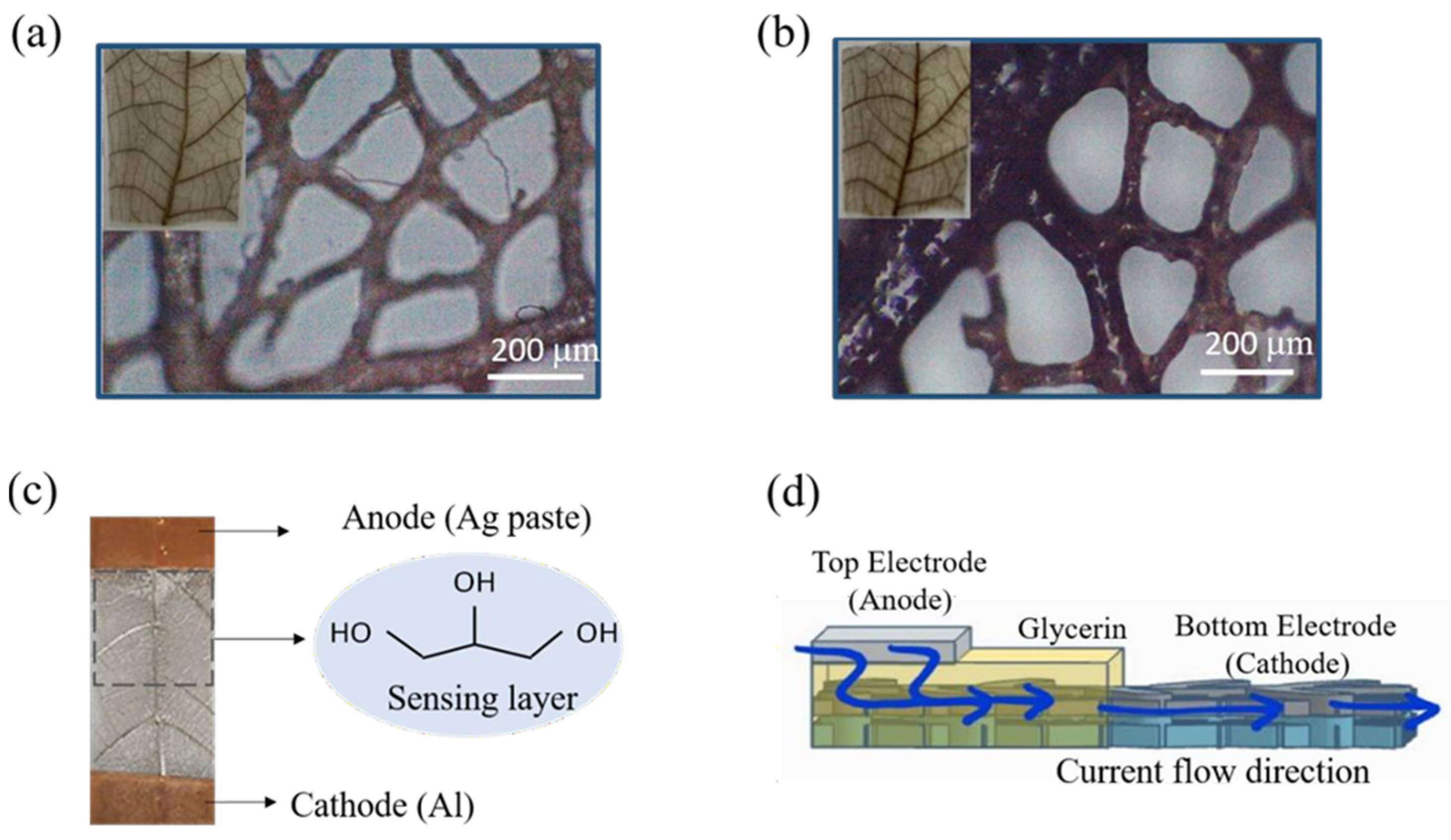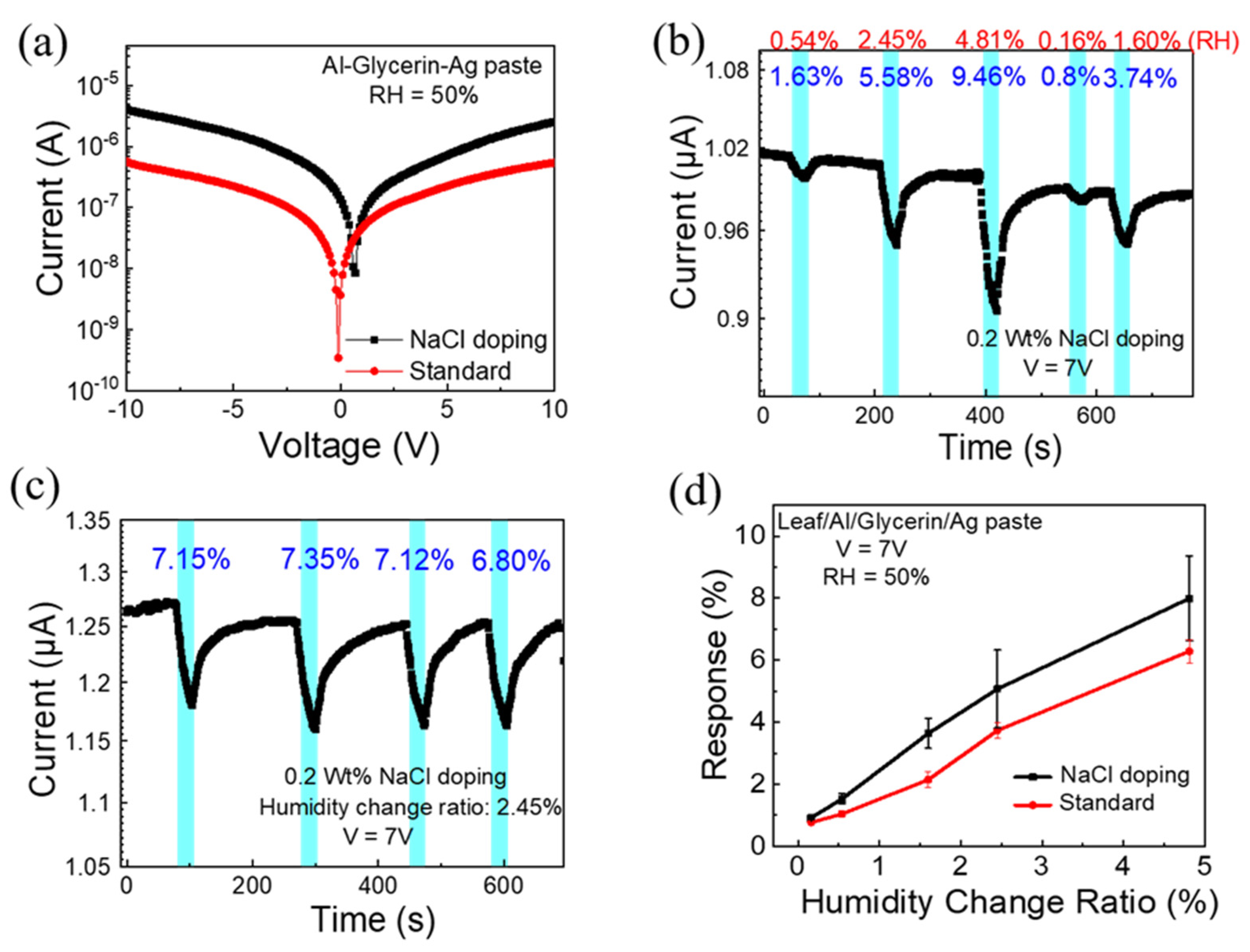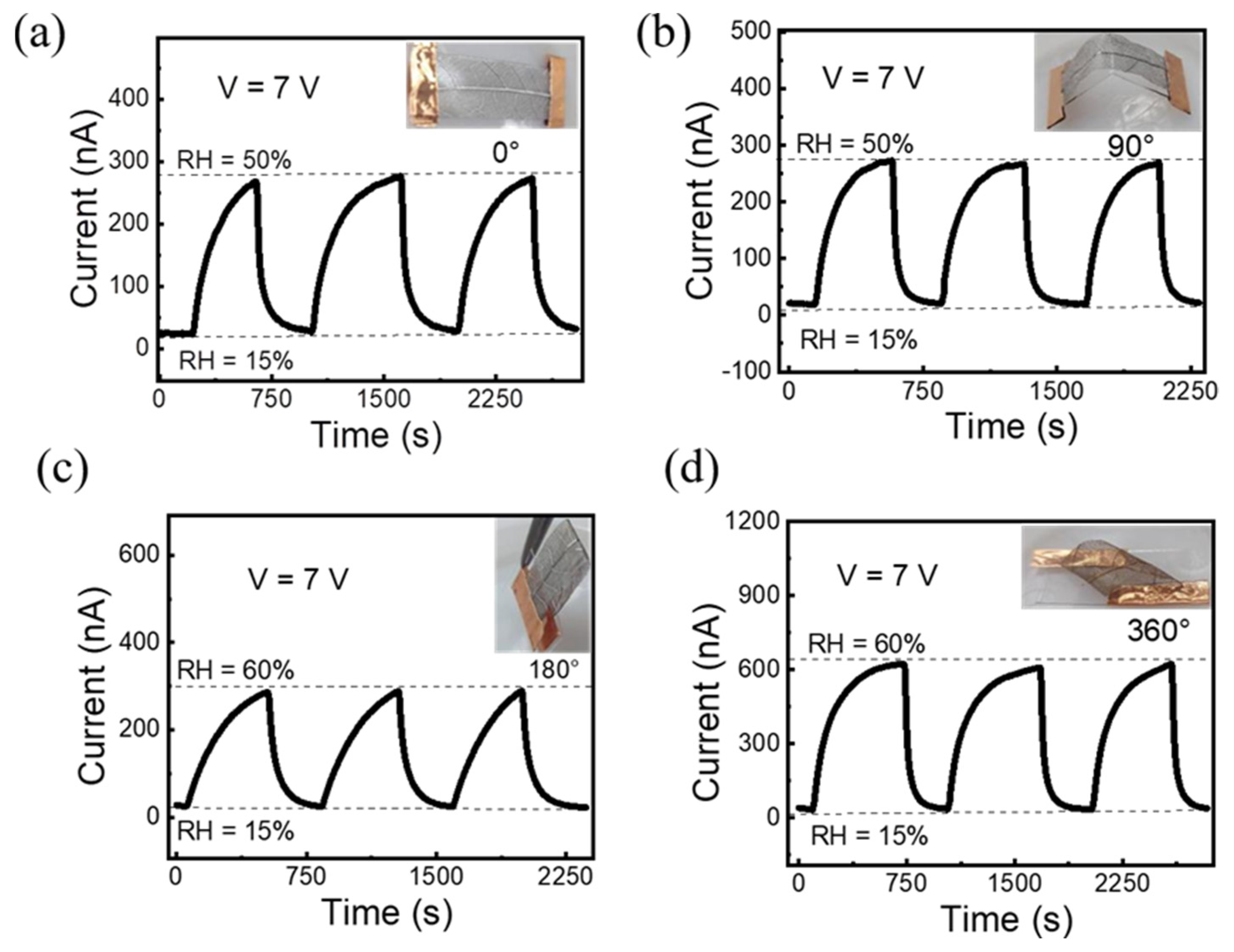Facile Fabrication of a Bio-Inspired Leaf Vein-Based Ultra-Sensitive Humidity Sensor with a Hygroscopic Polymer
Abstract
:1. Introduction
2. Experimental Section
2.1. Materials and Sensor Fabrication Details
2.2. Sensing System
3. Result and Discussion
The Sensing Behavior
4. Conclusions
Supplementary Materials
Author Contributions
Funding
Institutional Review Board Statement
Data Availability Statement
Conflicts of Interest
References
- Syu, M.H.; Guan, Y.J.; Lo, W.C.; Fuh, Y.K. Biomimetic and porous nanofiber-based hybrid sensor for multifunctional pressure sensing and human gesture identification via deep learning method. Nano Energy 2020, 76, 105029. [Google Scholar] [CrossRef]
- Yamamoto, Y.; Yamamoto, D.; Takada, M.; Naito, H.; Arie, T.; Akita, S.; Takei, K. Efficient skin temperature sensor and stable gel-less sticky ECG sensor for a wearable flexible healthcare patch. Adv. Healthc. Mater. 2017, 6, 1700495. [Google Scholar] [CrossRef] [PubMed]
- Jeong, K.; Lee, Y.; Kim, Y.; Mun, H.; Kyung, K.U.; Im, S.G. A Sub-Micron-Thick stretchable adhesive layer for the lamination of arbitrary elastomeric substrates with enhanced adhesion stability. Chem. Eng. J. 2022, 429, 132250. [Google Scholar] [CrossRef]
- Zhang, S.; Chhetry, A.; Zahed, M.; Sharma, S.; Park, C.; Yoon, S.; Park, J.Y. On-skin ultrathin and stretchable multifunctional sensor for smart healthcare wearables. Npj Flex. Electron. 2022, 11, 1–12. [Google Scholar] [CrossRef]
- Park, S.; Heo, S.W.; Lee, W.; Inoue, D.; Jiang, Z.; Yu, K.; Jinno, H.; Hashizume, D.; Sekino, M.; Yokota, T.; et al. Self-powered ultra-flexible electronics via nano- grating-patterned organic photovoltaics. Nature 2018, 561, 516–552. [Google Scholar] [CrossRef]
- Zhao, P.; Tang, Q.; Zhao, X.; Tong, Y.; Liu, Y. Highly stable and flexible transparent conductive polymer electrode patterns for large-scale organic transistors. J. Colloid Interface Sci. 2018, 520, 58–63. [Google Scholar] [CrossRef]
- Jiang, C.; Zhou, B.; Wei, Z.; Zheng, G.; Ji, Y.; Mi, L.; Dai, K.; Liu, C.; Shen, C. Transparent conductive flexible trilayer films for a deicing window and self-recover bending sensor based on a single-walled carbon nanotube/polyvinyl butyral interlayer. ACS Appl. Mater. Interfaces 2020, 12, 1454–1464. [Google Scholar] [CrossRef]
- Rickhaus, P.; de Vries, F.K.; Zhu, J.; Portoles, E.; Zheng, G.; Masseroni, M.; Kurzmann, A.; Taniguchi, T.; Watanabe, K.; MacDonald, A.H.; et al. Correlated electron-hole state in twisted double-bilayer graphene. Science 2021, 373, 1257–1260. [Google Scholar] [CrossRef]
- Zhao, Y.; Wang, J.; Li, Z.; Zhang, X.; Tian, M.; Zhang, X.; Liu, X.; Qu, L.; Zhu, S. Washable, durable and flame retardant conductive textiles based on reduced graphene oxide modification. Cellulose 2020, 27, 1763–1771. [Google Scholar] [CrossRef]
- Patil, J.J.; Chae, W.H.; Trebach, A.; Carter, K.J.; Lee, E.; Sannicolo, T.; Grossman, J.C. Failing forward: Stability of transparent electrodes based on metal nanowire networks. Adv. Mater. 2021, 33, 2004356. [Google Scholar] [CrossRef]
- Gao, J.; Xian, Z.; Zhou, G.; Liu, J.M.; Kempa, K. Nature-Inspired Metallic Networks for Transparent Electrodes. Adv. Funct. Mater. 2018, 28, 1705023. [Google Scholar] [CrossRef]
- Han, B.; Huang, Y.; Li, R.; Peng, Q.; Luo, J.; Pei, K.; Herczynski, A.; Kempa, K.; Ren, Z.; Gao, J. Bio-inspired networks for optoelectronic applications. Nat. Commun. 2014, 5, 1–7. [Google Scholar] [CrossRef] [PubMed] [Green Version]
- Jia, G.; Plentz, J.; Dellith, A.; Schmidt, C.; Dellith, J.; Schmidl, G.; Andrä, G. Biomimic Vein-Like Transparent Conducting Electrodes with Low Sheet Resistance and Metal Consumption. Nano-Micro Lett. 2020, 12, 1–13. [Google Scholar] [CrossRef] [Green Version]
- Alshehri, E.M.; Alarfaj, N.A.; Al-Tamimi, S.A.; El-Tohamy, M.F. Ultrasensitive Functionalized Polymeric-Nanometal Oxide Sensors for Potentiometric Determination of Ranitidine Hydrochloride. Polymers 2022, 14, 4150. [Google Scholar] [CrossRef]
- Martínez-Aviño, A.; de Diego-Llorente-Luque, M.; Molins-Legua, C.; Campíns-Falcó, P. Advances in the Measurement of Polymeric Colorimetric Sensors Using Portable Instrumentation: Testing the Light Influence. Polymers 2022, 14, 4285. [Google Scholar] [CrossRef]
- Dico, G.L.; Wicklein, B.; Lisuzzo, L.; Lazzara, G.; Aranda, P.; Ruiz-Hitzky, E. Multicomponent bionanocomposites based on clay nanoarchitectures for electrochemical devices. Beilstein J. Nanotechnol. 2019, 10, 1303–1315. [Google Scholar] [CrossRef]
- Qiang, Y.X.; Zhu, C.H.; Wu, Y.P.; Cui, S.; Liu, Y. Bio-inspired semi-transparent silver nanowire conductor based on a vein network with excellent electromechanical and photothermal properties. RSC Adv. 2018, 8, 23066. [Google Scholar] [CrossRef] [Green Version]
- Liu, Y.; He, K.; Chen, G.; Leow, W.R.; Chen, X. Nature-inspired structural materials for flexible electronic devices. Chem. Rev. 2017, 117, 12893–12941. [Google Scholar] [CrossRef]
- Thekkekara, L.V.; Gu, M. Bioinspired fractal electrodes for solar energy storages. Sci. Rep. 2017, 7, 45585. [Google Scholar] [CrossRef] [Green Version]
- Qu, T.Y.; Zuo, L.J.; Chen, J.D.; Shi, X.; Zhang, T.; Li, L.; Shen, K.C.; Ren, H.; Wang, S.; Xie, F.M.; et al. Biomimetic electrodes for flexible organic solar cells with efficiencies over 16%. Adv. Opt. Mater. 2020, 8, 2000669. [Google Scholar] [CrossRef]
- Trung, T.Q.; Lee, N.E. Materials and devices for transparent stretchable electronics. J. Mater. Chem. C 2017, 5, 2202. [Google Scholar] [CrossRef]
- Yu, Y.; Zhang, Y.; Li, K.; Yan, C.; Zheng, Z. Bio-Inspired Chemical Fabrication of Stretchable Transparent Electrodes. Small 2015, 11, 3444–3449. [Google Scholar] [CrossRef]
- Sepat, N.; Sharma, V.; Singh, D.; Makhija, G.; Sachdev, K. Nature-inspired bilayer metal mesh for transparent conducting electrode application. Mater. Lett. 2018, 232, 95–98. [Google Scholar] [CrossRef]
- Yoon, J.; Hou, Y.; Knoepfel, A.M.; Yang, D.; Ye, T.; Zheng, L.; Yennawar, N.; Sanghadasa, M.; Priya, S.; Wang, K. Bio-inspired strategies for next-generation perovskite solar mobile power sources. Chem. Society. Rev. 2021, 50, 12915. [Google Scholar] [CrossRef]
- Sepat, N.; Sharma, V.; Singh, S.; Sachdev, K. Bioinspired metal mesh structure with significant electrical and optical properties. Adv. Electron. Mater. 2019, 5, 1800318. [Google Scholar] [CrossRef] [Green Version]
- Chen, J.; Li, Z.; Ni, F.; Ouyang, W.; Fang, X. Bio-inspired transparent MXene electrodes for flexible UV photodetectors. Mater. Horiz. 2020, 7, 1828–1833. [Google Scholar] [CrossRef]
- Fan, Q.; Miao, J.; Liu, X.; Zuo, X.; Zhang, W.; Tian, M.; Zhu, S.; Qu, L.; Zhang, X. Biomimetic hierarchically silver nanowire interwoven MXene mesh for flexible transparent electrodes and invisible camouflage electronics. Nano Lett. 2022, 22, 740–750. [Google Scholar] [CrossRef]
- Keller, P.; Kawasaki, H. Conductive leaf vein networks produced via Ag nanoparticle self- assembly for potential applications of flexible sensor. Mater. Lett. 2021, 284, 128937. [Google Scholar] [CrossRef]
- Liu, Y.; Tao, J.; Yang, W.; Zhang, Y.; Li, J.; Xie, H.; Bao, R.; Gao, W.; Pan, C. Biodegradable, Breathable Leaf Vein-Based Tactile Sensors with Tunable Sensitivity and Sensing Range. Small 2022, 18, 2106906. [Google Scholar] [CrossRef]
- Farahani, H.; Wagiran, R.; Hamidon, M.N. Humidity sensors principle, mechanism, and fabrication technologies: A comprehensive review. Sensors 2014, 14, 7881–7939. [Google Scholar] [CrossRef]
- Tousi, M.M.; Zhang, Y.; Wan, S.; Yu, L.; Hou, C.; Yan, N.; Fink, Y.; Wang, A.; Jia, X. Scalable Fabrication of Highly Flexible Porous Polymer-Based Capacitive Humidity Sensor Using Convergence Fiber Drawing. Polymers 2019, 11, 1985. [Google Scholar] [CrossRef] [Green Version]
- Anisimov, Y.A.; Evitts, R.W.; Cree, D.E.; Wilson, L.D. Polyaniline/Biopolymer Composite Systems for Humidity Sensor Applications: A Review. Polymers 2021, 13, 2722. [Google Scholar] [CrossRef]
- Zhang, M.; Wang, M.; Zhang, M.; Qiu, L.; Liu, Y.; Zhang, W.; Zhang, Y.; Hu, J.; Wu, G. Flexible and Highly Sensitive Humidity Sensor Based on Sandwich-Like Ag/Fe3O4 Nanowires Composite for Multiple Dynamic Monitoring. Nanomaterials 2019, 9, 1399. [Google Scholar] [CrossRef] [Green Version]
- Turkani, V.S.; Maddipatla, D.; Narakathu, B.B.; Saeed, T.S.; Obare, S.O.; Bazuin, B.J.; Atashbar, M.Z. A highly sensitive printed humidity sensor based on a functionalized MWCNT/HEC composite for flexible electronics application. Nanoscale Adv. 2019, 6, 2311–2322. [Google Scholar] [CrossRef] [Green Version]
- Duan, Z.H.; Zhao, Q.N.; Li, C.Z.; Wang, S.; Jiang, Y.D.; Zhang, Y.J.; Liu, B.H.; Tai, H.L. Enhanced positive humidity sensitive behavior of p-reduced graphene oxide decorated with n-WS2 nanoparticles. Rare Met. 2021, 40, 1762–1767. [Google Scholar] [CrossRef]
- Park, H.; Lee, S.; Jeong, S.H.; Jung, U.H.; Park, K.; Lee, M.G.; Kim, S.; Lee, J. Enhanced Moisture-Reactive Hydrophilic-PTFE-Based Flexible Humidity Sensor for Real-Time Monitoring. Sensors 2018, 18, 921. [Google Scholar] [CrossRef] [PubMed] [Green Version]
- Razza, N.; Blanchet, B.; Lamberti, A.; Pirri, F.C.; Tulliani, J.M.; Bozano, L.D.; Sangermano, M. UV-printable and flexible humidity sensors based on conducting/insulating semi-interpenetrated polymer networks. Macromol. Mater. Eng. 2017, 2, 1700161. [Google Scholar] [CrossRef]
- Tai, H.; Wang, S.; Duan, Z.; Jiang, Y. Evolution of breath analysis based on humidity and gas sensors: Potential and challenges. Sens. Actuators B Chem. 2020, 318, 128104. [Google Scholar] [CrossRef]
- Zhen, Z.; Li, Z.; Zhao, X.; Zhong, Y.; Zhang, L.; Chen, Q.; Yang, T.; Zhu, H. Formation of uniform water microdroplets on wrinkled graphene for ultrafast humidity sensing. Small 2018, 14, 1703848. [Google Scholar] [CrossRef] [PubMed]
- Yoshida, A.; Wang, Y.F.; Tachibana, S.; Hasegawa, A.; Sekine, T.; Takeda, Y.; Hong, J.; Kumaki, D.; Shiba, T.; Tokito, S. Printed, all-carbon-based flexible humidity sensor using a cellulose nanofiber/graphene nanoplatelet composite. Carbon Trends 2022, 7, 100166. [Google Scholar] [CrossRef]
- McGhee, J.R.; Sagu, J.S.; Southee, D.J.; Evans, P.S.; Wijayantha, K.U. Printed, fully metal oxide, capacitive humidity sensors using conductive indium tin oxide inks. ACS Appl. Electron. Mater. 2020, 2, 3593–3600. [Google Scholar] [CrossRef]
- Guan, X.; Yu, Y.; Hou, Z.; Wu, K.; Zhao, H.; Liu, S.; Fei, T.; Zhang, T. A flexible humidity sensor based on self-supported polymer film. Sens. Actuators B Chem. 2022, 358, 131438. [Google Scholar] [CrossRef]
- Dai, J.; Zhang, T.; Zhao, H.; Fei, T. Preparation of organic-inorganic hybrid polymers and their humidity sensing properties. Sens. Actuators B Chem. 2017, 242, 1108–1114. [Google Scholar] [CrossRef]
- Ogura, K.; Fujii, A.; Shiigi, H.; Nakayama, M.; Tonosaki, T. Effect of hygroscopicity of insulating unit of polymer composites on their response to relative humidity. J. Electrochem. Soc. 2000, 147, 1105–1109. [Google Scholar] [CrossRef]
- Sidhu, N.K.; Sohi, P.A.; Kahrizi, M. Polymer based optical humidity and temperature sensor. Mater. Electron. 2019, 30, 3069–3077. [Google Scholar] [CrossRef]
- Wu, K.; Guan, X.; Hou, Z.; Liu, L.; Zhao, H.; Liu, S.; Fei, T.; Zhang, T. Humidity sensors based on metal organic frameworks derived polyelectrolyte films. J. Colloid Interface Sci. 2021, 602, 646–653. [Google Scholar] [CrossRef]
- Al-Hayali, S.K.; Salman, A.M.; Al-Janabi, A.H. Effect of hygroscopic polymer-coatings on the performance of relative humidity sensor based on macro-bend single-mode fiber. Opt. Fiber Technol. 2021, 62, 102460. [Google Scholar] [CrossRef]
- Goyal, S.; Hernández, N.B.; Cochran, E.W. An update on the future prospects of glycerol polymers. Polym. Int. 2021, 70, 911–917. [Google Scholar] [CrossRef]
- Zhang, H.; Grinstaff, M.W. Recent advances in glycerol polymers: Chemistry and biomedical applications. Macromol. Rapid Commun. 2014, 35, 1906–1924. [Google Scholar] [CrossRef]
- Chen, W.L.; Chiu, H.C.; Chu, H.; Hsieh, J.C.; Chen, B.X.; Tian, Y.C.; Liau, S.K.; Chan, M.J.; Lu, C.J.; Meng, H.F.; et al. Electronic nano sponge breath ammonia sensors using hygroscopic polymers on vertical channel nano-porous structure. J. Mater. Chem. C 2021, 9, 12938–12950. [Google Scholar] [CrossRef]






| Type of Leaf | Leaf Electrode | Coating Method | Sensing Layer | Application | Ref. |
|---|---|---|---|---|---|
| Magnolia quinquepeta | Leaf/Ag NPs | Dip coating | PAA-Ag NPs | Pressure sensor | [26] |
| Magnolia alba | Leaf/Mxene/Ag NWs | Dip coating | Ag NWs | Pressure sensor | [25] |
| Magnolia liliiflora | Leaf/Cu/Ag | Electroplating | [13] | ||
| Magnolia alba | Leaf/Ag | Sputtering | [11] | ||
| Magnolia alba | Leaf/Ag | Sputtering | [12] | ||
| Magnolia liliiflora | Leaf/Ag NWs | Spin coating | Ag NWs | Tactile sensor | [27] |
| Myrica rubra | Leaf/Ag NWs | Dip coating | TiO2 | UV photodetector | [24] |
| Bauhinia variegata | Leaf/Ag NWs | Thermal evaporation | Glycerin | Humidity sensor | This work |
| Flexible Substrates | Sensing Layer | RH Range | Operating Temperature (°C) | Sensitivity | Response/Recovery | Ref. |
|---|---|---|---|---|---|---|
| Polypropylene | Ag/Fe3O4 NWs | 11–95% | 25 | 2.14 at 11% RH | RH dependent | [33] |
| PET | MWCNT/hydroxyethyl Cellulose | 20–80% | 25 | 0.048/% RH | 20 s/− | [34] |
| PDMS | Sodium niobate (NaNbO3 NFs) | 5–80% | 25 | 2 mV/% RH | >12 s/20 s | [35] |
| PET | Polytetrafluoroethylene | 45–90% | 24–80 | [36] | ||
| PDMS | Polypyrrole (PPy) | 20–97% | 25 | RH dependent | [37] | |
| Leaf vein | Glycerin | 0.4–70% | 25 | 1.40 at 0.4% RH | RH dependent | This work |
Publisher’s Note: MDPI stays neutral with regard to jurisdictional claims in published maps and institutional affiliations. |
© 2022 by the authors. Licensee MDPI, Basel, Switzerland. This article is an open access article distributed under the terms and conditions of the Creative Commons Attribution (CC BY) license (https://creativecommons.org/licenses/by/4.0/).
Share and Cite
Li, P.-H.; Madhaiyan, G.; Shin, Y.-Y.; Tsai, H.-Y.; Meng, H.-F.; Horng, S.-F.; Zan, H.-W. Facile Fabrication of a Bio-Inspired Leaf Vein-Based Ultra-Sensitive Humidity Sensor with a Hygroscopic Polymer. Polymers 2022, 14, 5030. https://doi.org/10.3390/polym14225030
Li P-H, Madhaiyan G, Shin Y-Y, Tsai H-Y, Meng H-F, Horng S-F, Zan H-W. Facile Fabrication of a Bio-Inspired Leaf Vein-Based Ultra-Sensitive Humidity Sensor with a Hygroscopic Polymer. Polymers. 2022; 14(22):5030. https://doi.org/10.3390/polym14225030
Chicago/Turabian StyleLi, Pin-Hsuan, Govindasamy Madhaiyan, Ying-Yi Shin, Hsu-Yang Tsai, Hsin-Fei Meng, Sheng-Fu Horng, and Hsiao-Wen Zan. 2022. "Facile Fabrication of a Bio-Inspired Leaf Vein-Based Ultra-Sensitive Humidity Sensor with a Hygroscopic Polymer" Polymers 14, no. 22: 5030. https://doi.org/10.3390/polym14225030






